Tom Kepler's Blog, page 32
June 2, 2012
Using a Blog as a Classroom Teaching Tool
 Look at the layout of this blog. (If you're receiving this as an email, click on the title to go to the actual blog site.)
Look at the layout of this blog. (If you're receiving this as an email, click on the title to go to the actual blog site.)It's got a header or masthead. It's got static pages and the tab link buttons to access them. It's got the active, changing (home) blog page. Archives and labels are available on the sidebar.
It seems that such a site should be useful in teaching a class, especially if the teacher has access to a smartboard or data projector so that it can be used with actual daily teaching. I've been experimenting with using a blog in teaching for the last couple of years, using closed blogs (blogs accessible only to invited individuals).
Things I plan to use next school year:
Have the main page a static page, providing an overview and links.Provide static pages for each of the eras taught. These static pages will provide main points for the era unit, links to teaching pages, and ancillary materials.Teaching pages and ancillary materials will be posted as daily blog pages. Links on an era's static page will make posts more easily accessible in future years of teaching.With 20 static pages and with the blog posts, student writing will be able to be posted.My YouTube channel will be integrated into the site with links to appropriate videos on eras, authors, and particular works.Using blog comments for student homeworkUsing Goodreads (especially reviews) as another site to provide interactive authenticity for students.Finding ways for students to become active on the site by using student websites.Connecting to Common Core standards and anchor models.The blog will be an open site, available to all. Things that did not work last year:
Posts were hard to access when just posted as a daily blog article. A year later, I'd have to search to find them. This should be solved by having a static page for each era, and the teaching blog posts added and linked on this page. Posts became too long and cumbersome because of embedded videos. I liked embedding videos on the actual blog post, but they took quite a bit of time to load and provided a lengthy post. This might be solved by adding videos to folders on my YouTube channel and then adding links to those videos to the teaching blog posts. Student work, such as slide shows, can be linked via Google Documents. This way, the best of student work as models can be available but not necessarily added to the teaching page.As a last note, the blog can be a great site for distance learning. Take those words "distance learning" and think about daily teaching. For students who are absent, the blog can provide access for them. They may be able to get most of the day's lesson, even though home in bed!
I'm excited about the possibilities.
Copyright 2012 by Thomas L. Kepler, all rights reserved
Published on June 02, 2012 06:00
May 31, 2012
Sustainable Memorial Day Weekend: Gardening and Camping
The weekend began with our car camping at our local state park, Lacey Keosauqua State Park.
Although my wife and I have bike-camped there before, this time we drove by car because we were camping with family. It's difficult to bring toys and snacks for kids when you're biking. It's just 25 miles to the park.
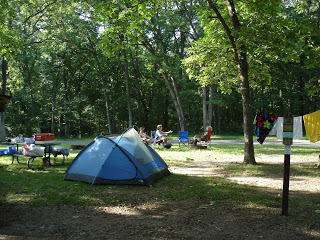 A camp in the non-electric sector--the electric was RV City!
A camp in the non-electric sector--the electric was RV City!
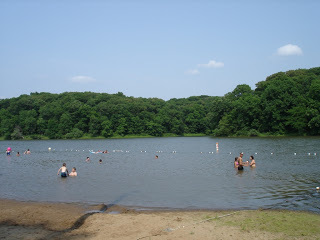 Early enough in the season to not be too green with algae.
Early enough in the season to not be too green with algae.
The weekend promised to be hot, but the first day we set up camp and then spent the day at the lake. I managed to stay pretty cool in the water and not get sunburned. I love it when a plan turns out well!
Sunday morning dawned with temperatures near eighty degrees, so we packed up early and came home. There was supposed to be record-breaking heat, and we decided to end our camp trip on the upside.
We found our neighbor girls looking for excitement when we arrived home, so we recruited them for pea picking and shelling. They enjoyed themselves immensely--and also found time for trips to the strawberry and raspberry beds.
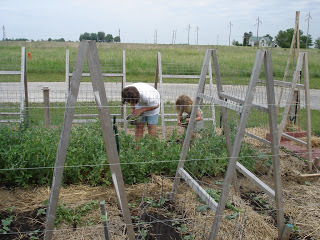 Searching for the elusive ripe pea pod . . .
Searching for the elusive ripe pea pod . . .
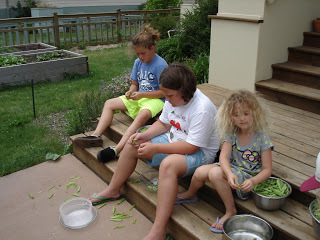 They practiced "basketball" shots with the empty shells.Teaching our children ecologically sustainable practices is important, and how fun to provide children with the experience that the outdoor and gardening can be fun!
They practiced "basketball" shots with the empty shells.Teaching our children ecologically sustainable practices is important, and how fun to provide children with the experience that the outdoor and gardening can be fun!
Copyright 2012 by Thomas L. Kepler, all rights reserved
Although my wife and I have bike-camped there before, this time we drove by car because we were camping with family. It's difficult to bring toys and snacks for kids when you're biking. It's just 25 miles to the park.
 A camp in the non-electric sector--the electric was RV City!
A camp in the non-electric sector--the electric was RV City! Early enough in the season to not be too green with algae.
Early enough in the season to not be too green with algae.The weekend promised to be hot, but the first day we set up camp and then spent the day at the lake. I managed to stay pretty cool in the water and not get sunburned. I love it when a plan turns out well!
Sunday morning dawned with temperatures near eighty degrees, so we packed up early and came home. There was supposed to be record-breaking heat, and we decided to end our camp trip on the upside.
We found our neighbor girls looking for excitement when we arrived home, so we recruited them for pea picking and shelling. They enjoyed themselves immensely--and also found time for trips to the strawberry and raspberry beds.
 Searching for the elusive ripe pea pod . . .
Searching for the elusive ripe pea pod . . .
 They practiced "basketball" shots with the empty shells.Teaching our children ecologically sustainable practices is important, and how fun to provide children with the experience that the outdoor and gardening can be fun!
They practiced "basketball" shots with the empty shells.Teaching our children ecologically sustainable practices is important, and how fun to provide children with the experience that the outdoor and gardening can be fun!Copyright 2012 by Thomas L. Kepler, all rights reserved
Published on May 31, 2012 04:50
May 24, 2012
I Love Free Books for My Kindle
 Every now and then I buy a book for my Kindle e-reader, but what I love most are all the free Kindle books.
Every now and then I buy a book for my Kindle e-reader, but what I love most are all the free Kindle books.Before I continue with my lovefest for free Kindle books, I need to note that there are other sources of free books.
Project Gutenberg is a wonderful source of public domain free e-books, having over 39,000 "classics" available. "We carry high quality ebooks: All our ebooks were previously published by bona fide publishers. We digitized and diligently proofread them with the help of thousands of volunteers." One day I'd like to be a volunteer. ManyBooks is another source I've used, with many downloads (29,000) available in many formats, like Project Gutenberg. ManyBooks has also put together a list of reviews about the many e-readers available, such as the various incarnations of Kindles, Nooks, and tablets.Google Books seems to have many online books available. Going to the "classics" section finds the free e-books that can be downloaded. I haven't used this service much, though.Kindle has many of the classics available for free downloads via the e-reader. It's easy, but it helps to know exactly the book or author you're looking for. Browsing Charles Dickens' books leads to more straightforward choices than browsing "Victorian novels," for instance.
I find the public domain books useful and interesting when looking for original sources. For instance, after reading a National Geographic article of the American Civil War, I was motivated to download Personal Memoirs of U.S. Grant (in two volumes). Evidently, this was dictated by Grant at the last of his life to Samuel Clemens. (An interesting story about the Grant/Clemens connection here.)
Another example of seeking out original sources is connected to the non-fiction book The River of Doubt: Theodore Roosevelt's Darkest Journey , by Candice Millard. I had checked the book out from my local library. Early in my reading of the book, I decided to download Roosevelt's version of his South American exploring, a book entitled Through the Brazilian Wilderness . Reading both versions of the same expedition was quite illuminating.
I find the books I buy for my Kindle are ones that I would call "disposable" books--ones I'll read but most likely not re-read, entertainment or recreational books that I can buy most cheaply as an e-book. Then, if I find myself really drawn to the book, I consider buying a paper version.
I like the idea of saving paper and lowering the carbon footprint of shipping by reading on an e-reader. I find the Kindle and Nook easy to read, easy on the eyes. Those are the two readers I've used extensively. I prefer the non-backlit screens of the e-ink readers, rather than a computer screen.
Try a free e-book download. "Classic" is a broad term--even if it just means a book is in the public domain and is no longer copyrighted. Jack London, Arthur Conan Doyle, and H.P. Lovecraft are all for free--but hardly "stuffy" classics. You might also try using the free-book sources to go to original sources. Grant's memoirs, for instance, are considered to be excellent examples of a more objective approach to generalship and the battles of the Civil War--not so much "the battles I generaled as a hero" focus.
E-books are a whole new world--one that I'm enjoying learning about and participating in, both as a reader and as an author.
Copyright 2012, by Thomas L. Kepler, all rights reserved
Published on May 24, 2012 04:00
May 22, 2012
Peter Jackson's The Hobbit
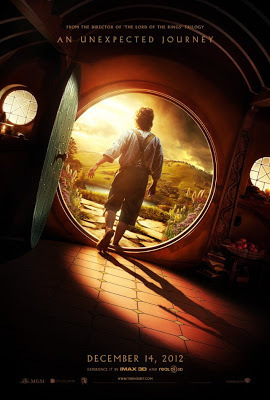 from IMDb OK, just watch the trailer.
from IMDb OK, just watch the trailer.Now that we've got your attention.
Even though the book The Hobbit precedes The Lord of the Rings, it appears in the trailer that Peter Jackson includes hints of what is to come in his movie version. This will, I suppose, create all these ties to the movie for fans who saw the trilogy first. I think this could be exciting.
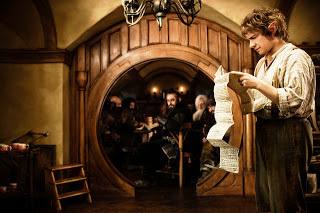 Production still from The Hobbit: an Unexpected JourneyHere is the link to The Hobbit Blog, the official site.
Production still from The Hobbit: an Unexpected JourneyHere is the link to The Hobbit Blog, the official site.And here is some commentary from the writer Aidy from the blog Aidy Reviews.
The screenplay for The Hobbitis written by Fran Walsh, PhilippaBoyens, Peter Jackson, and Guillermo del Toro, adapted from J.R.R.Tolkien’s famous novel. The quest written by one Bilbo Baggins, a shireloving Hobbit, who was whisked away on an adventure by the wizardGandalf , who tricked Bilbo into hosting a small party for 12 dwarveswho take Bilbo deep into the Misty Mountains, where he encounters thecreature Gollum, and finds the mysterious “one ring,” that is the focusof The Lord Of The Ringstale.Copyright retained by the respective sites linked to.
The trailer serves as a long-awaited preview of what’s to come in themovie—movies, I should say, Jackson decided to stretch the film into twomovies which gives them the opportunity to bring in some unique materielthat’s not in the original Tolkien’s books. But what he is doing here isthis: he’s giving fans of The Hobbit and LOTR series a broaderperspective of middle earth, by bringing in more visuals, landscapes,and characters. You can see a little bit of this in the trailer. Also,in the trailer you see the elf Galadriel (Cate Blanchett), who is oneof the featured characters in The Lord Of The Rings book trilogy– sheis not in the original tale of Tolkien’s The Hobbit.
In the book and as it will be in the film, the wizard Gandalf (IanMcKellen), disappears to participate in the White Council meetings–thefilm will make note of those events. Also you see the “younger” BilboBaggins (Martin Freeman), and a descriptive montage of his dwarvencompanions–eager to reclaim the treasure the dragon Smaug stole. Evenmore intriguing is that you will see and hear the song–poem about the“Misty Mountains” being sung; however, what you do not see, is thehighly anticipated view of the dragon Smaug. We also get to see andhear, the creature Gollum (Andy Serkis), deep in the dark cave of theMisty Mountains, where Bilbo finds “the One Ring.”
Published on May 22, 2012 04:00
May 18, 2012
How Autobiographical Is Our Writing?
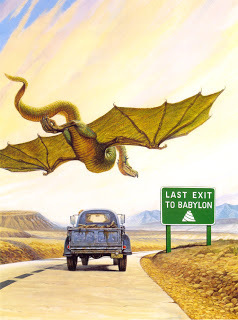 All novels are autobiographical, except the parts we make up. How can we write other than what we know? However, is a novel nothing other than a journalistic memoir? My first novel, Love Ya Like a Sister, is a young adult novel that had a main character whose mother has died. My first wife passed away when my son was sixteen. The main character also has two sisters who are his neighbors, as did I when I grew up. The story is set in a small town that is much like the small town I taught school in for twenty-one years. My second novel, a fantasy novel, is about a young man, Glimmer, who is an apprentice magician who practices his magic only in his dreams. He has issues with dragons. How can that be autobiographical? The Stone Dragon is completely autobiographical, though, excepting the fact that I made it all up.Actually, neither novel is autobiographical. It's too much fun as an author to make stuff up--much more fun than just writing about my life. However: all novels are autobiographical because they are based on the author's experience.How do we resolve the paradox?How do we write about pain or love or walking barefoot in the sand unless we have experienced those things? We do write from our experience, but we also selectively choose from our experience and extend, extrapolate, and transform those experiences into something new.I have the experience of whacking my funny bone, and my elbow really hurts--for a bit. Almost everyone has had that experience. I use that experience when writing about pain. Or perhaps the needed experience of pain is different, so I remember the pain of getting my finger smashed in a door.
All novels are autobiographical, except the parts we make up. How can we write other than what we know? However, is a novel nothing other than a journalistic memoir? My first novel, Love Ya Like a Sister, is a young adult novel that had a main character whose mother has died. My first wife passed away when my son was sixteen. The main character also has two sisters who are his neighbors, as did I when I grew up. The story is set in a small town that is much like the small town I taught school in for twenty-one years. My second novel, a fantasy novel, is about a young man, Glimmer, who is an apprentice magician who practices his magic only in his dreams. He has issues with dragons. How can that be autobiographical? The Stone Dragon is completely autobiographical, though, excepting the fact that I made it all up.Actually, neither novel is autobiographical. It's too much fun as an author to make stuff up--much more fun than just writing about my life. However: all novels are autobiographical because they are based on the author's experience.How do we resolve the paradox?How do we write about pain or love or walking barefoot in the sand unless we have experienced those things? We do write from our experience, but we also selectively choose from our experience and extend, extrapolate, and transform those experiences into something new.I have the experience of whacking my funny bone, and my elbow really hurts--for a bit. Almost everyone has had that experience. I use that experience when writing about pain. Or perhaps the needed experience of pain is different, so I remember the pain of getting my finger smashed in a door.
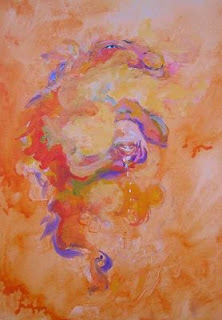 A first kiss in a relationship . . . a moment of discovery . . . jumping into a cold mountain stream . . . being thirsty after mowing the lawn on a hot summer afternoon . . . The universal value of the novel is the made-up storyline. A young man in a land where magic exists discovers his magical abilities and conjures a series of dragons--and must face the responsibility that comes with creation.The point value of all the details of the novel can be derived from personal (or autobiographial) experience. Glimmer works in his garden--the weighty hand mattock, the warm earth in his hands, the prickly thistle to be pulled. I've experienced these things. I've seen movies and photographic magnifications of the boiling, roiling sun. Those experiences were useful in The Stone Dragon.Perhaps it would be true to say that fiction writing is stitching the fabric of life into a new cloth, of pulling apart the old threads and weaving them into a new garment. We are the sum total of our experiences, plus a significant bit more. A novel is an exercise in autobiography, except for the parts that never happened. We tell the story we want to tell. Who cares what really happened?Copyright 2012 by Thomas L. Kepler, all rights reserved
A first kiss in a relationship . . . a moment of discovery . . . jumping into a cold mountain stream . . . being thirsty after mowing the lawn on a hot summer afternoon . . . The universal value of the novel is the made-up storyline. A young man in a land where magic exists discovers his magical abilities and conjures a series of dragons--and must face the responsibility that comes with creation.The point value of all the details of the novel can be derived from personal (or autobiographial) experience. Glimmer works in his garden--the weighty hand mattock, the warm earth in his hands, the prickly thistle to be pulled. I've experienced these things. I've seen movies and photographic magnifications of the boiling, roiling sun. Those experiences were useful in The Stone Dragon.Perhaps it would be true to say that fiction writing is stitching the fabric of life into a new cloth, of pulling apart the old threads and weaving them into a new garment. We are the sum total of our experiences, plus a significant bit more. A novel is an exercise in autobiography, except for the parts that never happened. We tell the story we want to tell. Who cares what really happened?Copyright 2012 by Thomas L. Kepler, all rights reserved
Published on May 18, 2012 04:29
May 16, 2012
Connecting with the Earth with a Garden
 Our north garden site, showcasing 3-dimensional structures"There's too much confusion. I can't get no relief." Bob Dylan
Our north garden site, showcasing 3-dimensional structures"There's too much confusion. I can't get no relief." Bob DylanTry spending some time in the garden. You might get some frustration along with the relief, but it's a straightforward kind of work--one with a solution. After last year's drought, this year we're hoping for timely rains.
One gardening goal this year is to regress and do more gardening barefoot--that's right, no shoes. Not much with shovel work, but picking and weeding I can do without shoes. I can cut asparagus barefoot and steam it for dinner, 8 minutes from the garden.
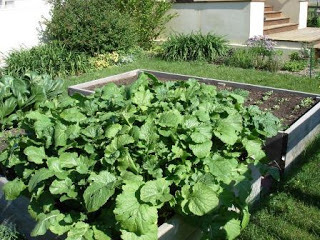 Turnip greens to the fore; Asian greens to the left.
Turnip greens to the fore; Asian greens to the left.I want to feel the grass and earth beneath my feet; I want to forget the emotions and issues of work and function within the greater boundaries of nature.
 Potatoes in the raised beds.The peas are looking good in the north garden, and the broccoli and brussel sprouts are coming along. Some climbing Japanese cucumbers have been transplanted to one of the A-frames. The bush green beans are up, as are the pole beans on the trellises. Soon we'll plant climbing pole limas--the purple and white speckled "Christmas" variety.
Potatoes in the raised beds.The peas are looking good in the north garden, and the broccoli and brussel sprouts are coming along. Some climbing Japanese cucumbers have been transplanted to one of the A-frames. The bush green beans are up, as are the pole beans on the trellises. Soon we'll plant climbing pole limas--the purple and white speckled "Christmas" variety. I haven't mentioned the strawberries, but that doesn't mean we haven't been eating them. What a wonderful way to begin the day--pick strawberries and have them with breakfast! The raspberries aren't ripe yet, but we expect them about the time the strawberries give out.
The big, unplanted raised bed to the right of the potatoes? That's for cantalopes and watermelons. Yum!
Maybe you should try connecting with the earth. It's a friendly place to be. And because last year we finished our raised beds, this year there's less intensive labor--more time for bicycling Fairfield's trail system!
Copyright 2012 by Thomas L. Kepler, all rights reserved
Published on May 16, 2012 07:54
May 10, 2012
"Wally, the Door Greeter": a story inspired by the opening of a super Wal-Mart in my town
 Shopping carts were rattling down the aisles of the Super Wal-Mart's grand opening, serious folk in blue aprons bustling about to assist the shoppers.
Shopping carts were rattling down the aisles of the Super Wal-Mart's grand opening, serious folk in blue aprons bustling about to assist the shoppers.The Manager noticed an empty space at the front of the store, though, where all the carts were supposed to be, all slid one inside the other in rows of neat readiness like dollar bills in a wallet.
"Wally," the Manager said, "you need to hit the parking lot and grab some carts. We're running low."
"I would prefer not to," Wally said in a perfectly deadpan manner.
The Manager was somewhat put off by the negative response. After all, the store would provide "70 new jobs, savings for local shoppers and an increase in tax revenue to support the area’s economy," according to the corporate website," but the Manager was busy, assumed Wally had good reason, and sent another blue-boy off for the carts.
Later on opening day, the Manager suggested to Wally that he separate some of the carts so that customers could easily grab them and roll off to consumer bliss.
"I would prefer not to," was Wally's response.
"But it's your job to be jolly and offer a cart," the Manager replied.
"I would prefer not to."
The afternoon progressed with conditional negatives, Wally doing nothing but staring out the window, customers muttering, "You can't fire him! Remember the baby movie Where the Heart Is !"
This was Wal-Mart, after all, and there were standards. The day ended with Wally sitting on one of those benches set in concrete in front of the sliding entrance doors. Wally might as well have been set in concrete.
The Manager tucked some stale french fries into the crook of Wally's arm, then turned to his car to leave for the night. A chance thought, and he returned to Wally and whispered in his ear, "Tomorrow we'll put you in charge of the Lost and Found department."
Wally made no response. The Manager was heartened, though, and decided the absence of the negative could be considered a positive. He would prefer to think so, anyway.
This story was suggested by "Bartleby the Scrivener," by Herman Melville.
Copyright 2012 by Thomas L. Kepler, all rights reserved
Published on May 10, 2012 04:49
May 8, 2012
Bicycle Commuter: Without a Car for Four Days
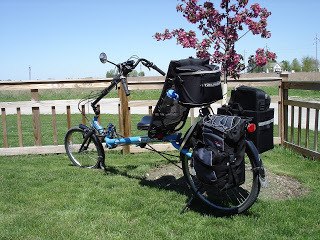
"Sure," I said to my wife, "you can take the car to the airport and leave it." After all, it was only four days, and I ride my bike to work most days, anyway.
Friday morning was a raining deluge, true adventure cycling weather. Rain whipped my face, and I squinted my eyes to see through the downpour. I lived through the southeastern Iowa gully-washer, though, with only a wet collar. It pays to have good rain gear.
Saturday and Sunday were hot and muggy, but the riding was easy--no big winds or rain. And Monday was cool and mild.
The difference between choosing to not drive the car and actually not having a car was interesting, though. The mind set was not the same. I knew I had no car and had to get to work, rain or shine, wind or calm. I knew the bike was the only way to go unless I wanted to bum a ride with a colleague or call a cab.
It's about two miles to work and town--no distance at all on a bicycle, once you get used to it. I saw all the cars, all the people in cars. It would be a different world if more people biked: a healthier world filled with healthier people.
It's May. Dust off that bicycle and take a spin. On a bike, you don't have to stop to smell the flowers.
Copyright 2012 by Thomas L. Kepler, all rights reserved
Published on May 08, 2012 04:23
May 3, 2012
Weird and Fun Things I've discovered
Sometimes, things that are just plain odd come by. Here are a few I've found.
John Keats caught on video, reading his own poetry!
Here is another. My addition to the image is as follows: "Keep clam and roofread."
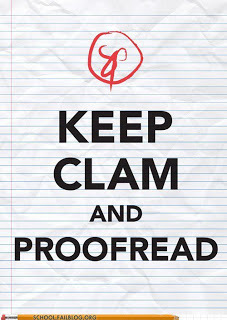
Even Mickey must have family that one wonders about.
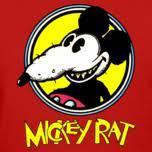
And the last--a comment on the limits of the internet.
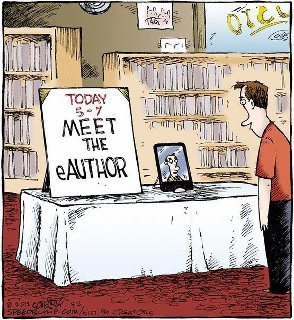

John Keats caught on video, reading his own poetry!
Here is another. My addition to the image is as follows: "Keep clam and roofread."

Even Mickey must have family that one wonders about.

And the last--a comment on the limits of the internet.

Published on May 03, 2012 04:15
April 28, 2012
Sentence Fluency: the Flow of Consciousness
 Learn to write by reading. This is good advice, but if we go back in time--way, way back--the whole process of reading and writing began with . . . a writer!
Learn to write by reading. This is good advice, but if we go back in time--way, way back--the whole process of reading and writing began with . . . a writer!Some would say this first Writer was the Creator, the primal force of existence: "In the beginning was the Word, and the Word was with God, and the Word was God."
That Primal Force didn't have trouble saying anything--speech became creation. In the same way, the writer is also a creator, but first the writer has to have something to say. Words have to flow. This flowing, in the field of education, is labeled the higher order thinking skill called fluency: many and diverse ideas. Each idea is a flowing of consciousness; each flowing is unique.
If sentences are written with fluency, they invite being read aloud: they have an easy flow or rhythm. Sentences vary in structure and length in a way that supports the meaning of what is being written. Transitions between ideas are effective and creative. Depending on the subject and purpose of the writing, sentence fragments or non-standard grammar may be used to create a particular effect. Dialogue, if used, is natural and believable.
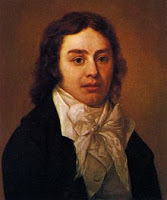 Samuel Taylor Coleridge stated in his Biographia Literaria (Chapter xiv), speaking within the context of poetry and of the Romantic poet William Wordsworth, that poetry ideally should flow in "a more than usual state of emotion, with more than usual order; judgement ever awake and steady self-possession, with enthusiasm and feeling profound or vehement; and while it blends and harmonizes the natural and the artificial, still subordinates art to nature; the manner to the matter . . ."
Samuel Taylor Coleridge stated in his Biographia Literaria (Chapter xiv), speaking within the context of poetry and of the Romantic poet William Wordsworth, that poetry ideally should flow in "a more than usual state of emotion, with more than usual order; judgement ever awake and steady self-possession, with enthusiasm and feeling profound or vehement; and while it blends and harmonizes the natural and the artificial, still subordinates art to nature; the manner to the matter . . ."All of this cannot be achieved by following a formula. This stuff comes from within, from the wholeness of the creative vision.
Maharishi Mahesh Yogi, founder of the Transcendental Meditation program, stated the relationship between literature and writer in the following manner: "[Literature's] essential force lies in the purity of the writer, in the purity of the consciousness of the writer, who is able to bring [the] ocean in a drop, the ocean seen in a drop, that microscopic vision, that microscopic appreciation which naturally comprehends the totality on any surface value of a thing" (16, The Flow of Consciousness ).
How can one improve sentence variety and creativity?
We must enrich our creativity. Expand our consciousness. For me, I do this with the Transcendental Meditation technique, practicing TM twice a day for 15-20 minutes, and then getting on with my writing. TM is a preparation for activity.
Now that the first Writer has written the Word, read lots of other words. Learn through example. Be self-referential. Put writing aside and then come back to it at a later date. Consider the "reader over your shoulder," your audience, as you read your writing again.Be a part of a writing community. The perspective of a trusted friend (especially a writing friend) is a valuable asset.Consider your purpose for writing. A simple shout of "Fire!" is appropriate if the blaze is roaring.All of us, writers or not, are creators with every observation, thought, and action we take. The quality of our writing is dependent upon the comprehensiveness of our consciousness. Writing is cosmic. Let's make the universe we create worthy of our Creator.
Copyright 2012 by Thomas L. Kepler, all rights reserved
Published on April 28, 2012 04:51



